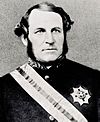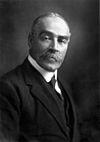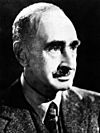Governor of Hong Kong facts for kids
Quick facts for kids Governor of Hong Kong |
|
|---|---|

Flag of the Governor of Hong Kong (1959–1997)
|
|

Coat of arms of Hong Kong (1959–1997)
|
|
| Style | His Excellency |
| Residence | Government House, Hong Kong |
| Appointer | Monarch of the United Kingdom |
| Formation | 26 June 1843 |
| First holder | Sir Henry Pottinger |
| Final holder | Chris Patten |
| Abolished | 30 June 1997 |
| Salary | HK$3,036,000 annually (1997) |
| Governor of Hong Kong | |||||||||||||
|---|---|---|---|---|---|---|---|---|---|---|---|---|---|
| Traditional Chinese | 香港總督 | ||||||||||||
| Simplified Chinese | 香港总督 | ||||||||||||
| Cantonese Yale | Hēunggóng Júngdūk | ||||||||||||
|
|||||||||||||
| Abbreviation | |||||||||||||
| Chinese | 港督 | ||||||||||||
| Cantonese Yale | Góngdūk | ||||||||||||
|
|||||||||||||
The Governor of Hong Kong was like the boss of Hong Kong when it was a British colony. This person represented the British Crown (the King or Queen) from 1843 until 1997.
The governor was in charge of the Executive Council, which was like a cabinet of advisors. They were also the commander-in-chief of the British military forces in Hong Kong. The rules for the governor's job were written in important documents called the Hong Kong Letters Patent and Royal Instructions.
When British rule ended and Hong Kong was returned to China in 1997, the governor's job changed. Most of their government duties went to the new chief executive of Hong Kong. The military duties went to the commander of the People's Liberation Army Hong Kong Garrison.
Contents
The Governor's Role
The governor's powers and duties were set out in official papers from 1843. The British King or Queen chose the governor, usually with advice from the Foreign Secretary. The governor led the government of Hong Kong during all the years it was a British colony.
For a long time, there wasn't much public voting for government leaders. This only started to change in the last few years of British rule.

The Governor of Hong Kong led the colony's main government group, the Executive Council (ExCo). Until 1993, the governor also led the Legislative Council (LegCo), which made laws.
The governor picked most of the people who served in LegCo. For many years, British people held most of these positions. But over time, more local Hong Kong Chinese people were chosen. Most governors were experienced diplomats or colonial officials. However, the last governor, Chris Patten, was a politician before he came to Hong Kong.
In 1996, the governor's yearly salary was about HK$3,036,000. This money was not taxed.
If the governor was away, the chief secretary would temporarily take over as acting governor. These chief secretaries were usually from the Colonial Office or the British military. During World War II, when Japan occupied Hong Kong, Japanese military officers served as administrators.
Governor's Transportation
The Governor of Hong Kong had special cars for getting around. They used a Daimler DS420 for everyday travel. For important ceremonies, they had a fancy Rolls-Royce Phantom V landaulet. Both cars were taken away by the Royal Navy right after Hong Kong was returned to China in 1997.
Governor's Homes
- The very first governor, Sir Henry Pottinger, lived in a building that is now the Former French Mission Building. He lived there from 1843 to 1846. Today, this building is home to the Hong Kong Court of Final Appeal.
- From the fourth governor, Sir John Bowring, onwards, governors lived at Government House. This was their official home, except for a period during World War II.
- During the Japanese occupation of Hong Kong from 1941 to 1945, the Japanese military governor lived at Flagstaff House. After the war, this house was given back to the Commander of British Forces.
List of Governors
This table shows some of the main British governors who led Hong Kong.
British Governors (1843–1941)
| No. | Portrait | Name (Birth–Death) |
Time in Office | From | Job Before | ||
|---|---|---|---|---|---|---|---|
| Started | Left | How Long | |||||
| 1 |  |
Sir Henry Pottinger 砵甸乍 (1789–1856) |
26 June 1843 | 8 May 1844 | 317 days | Ballymacarrett, Ireland | Lieutenant-General |
| 2 |  |
Sir John Francis Davis 戴維斯 (1795–1890) |
8 May 1844 | 21 March 1848 | 3 years, 315 days | London, England | Chief Superintendent of British Trade in China |
| 3 |  |
Sir George Bonham 文咸 (1803–1863) |
21 March 1848 | 13 April 1854 | 6 years, 23 days | London, England | East India Company |
| 4 |  |
Sir John Bowring 寶靈 (1792–1872) |
13 April 1854 | 2 May 1859 | 5 years, 19 days | Exeter, England | Member of Parliament (MP) |
| 5 |  |
Sir Hercules Robinson 羅士敏 (1824–1897) |
9 September 1859 | 15 March 1865 | 5 years, 187 days | Westmeath, Ireland | Colonial administrator |
| 6 |  |
Sir Richard Graves MacDonnell 麥當奴 (1814–1881) |
12 March 1866 | 11 April 1872 | 6 years, 30 days | Dublin, Ireland | Colonial administrator |
| 7 |  |
Sir Arthur Kennedy 堅尼地 (1809–1883) |
16 April 1872 | 1 March 1877 | 4 years, 319 days | County Down, Ireland | Colonial administrator |
| 8 |  |
Sir John Pope Hennessy 軒尼詩 (1834–1891) |
23 April 1877 | 7 March 1882 | 4 years, 318 days | County Cork, Ireland | Colonial administrator |
| 9 |  |
Sir George Bowen 寶雲 (1821–1899) |
30 March 1883 | 21 December 1885 | 2 years, 266 days | County Donegal, Ireland | Colonial administrator |
| 10 |  |
Sir William Des Vœux 德輔 (1834–1909) |
6 October 1887 | 7 May 1891 | 3 years, 213 days | Baden-Baden, German Confederation | Colonial administrator |
| 11 |  |
Sir William Robinson 羅便臣 (1836–1912) |
10 December 1891 | 1 February 1898 | 6 years, 53 days | Wetherden, England | Colonial administrator |
| 12 |  |
Sir Henry Arthur Blake 卜力 (1840–1918) |
25 November 1898 | 21 November 1903 | 4 years, 361 days | Limerick, Ireland | Colonial administrator |
| 13 |  |
Sir Matthew Nathan 彌敦 (1862–1939) |
29 July 1904 | 20 April 1907 | 2 years, 265 days | London, England | Colonial administrator |
| 14 |  |
Sir Frederick Lugard 盧吉 (1858–1945) |
29 July 1907 | 16 March 1912 | 4 years, 231 days | Madras, India | Colonial administrator |
| 15 |  |
Sir Francis Henry May 梅含理 (1860–1922) |
4 July 1912 | 12 September 1918 | 6 years, 70 days | Dublin, Ireland | Colonial Secretary |
| 16 |  |
Sir Reginald Edward Stubbs 司徒拔 (1876–1947) |
30 September 1919 | 31 October 1925 | 6 years, 31 days | Oxford, England | Colonial administrator |
| 17 |  |
Sir Cecil Clementi 金文泰 (1875–1947) |
1 November 1925 | 1 February 1930 | 4 years, 92 days | Cawnpore, India | Colonial administrator |
| 18 |  |
Sir William Peel 貝璐 (1875–1945) |
9 May 1930 | 17 May 1935 | 5 years, 8 days | Hexham, England | Colonial administrator |
| 19 |  |
Sir Andrew Caldecott 郝德傑 (1884–1951) |
12 December 1935 | 16 April 1937 | 1 year, 125 days | Kent, England | Colonial administrator |
| 20 |  |
Sir Geoffry Northcote 羅富國 (1881–1948) |
28 October 1937 | 6 September 1941 | 3 years, 313 days | London, England | Colonial administrator |
| 21 |  |
Sir Mark Aitchison Young 楊慕琦 (1886–1974) |
10 September 1941 | 25 December 1941 | 106 days | India | Colonial administrator |
Japanese Occupation (1941–1945)
During World War II, Japan took control of Hong Kong. These were the Japanese administrators.
| No. | Portrait | Name (Birth–Death) |
Time in Office | From | Job Before | ||
|---|---|---|---|---|---|---|---|
| Started | Left | How Long | |||||
| 1 |  |
Rensuke Isogai 磯谷廉介 (1886–1967) |
20 February 1942 | 24 December 1944 | 2 years, 308 days | Tanba, Hyōgo | Lieutenant general |
| 2 |  |
Hisakazu Tanaka 田中久一 (1889–1947) |
1 February 1945 | 16 August 1945 | 196 days | Himeji, Hyōgo | Lieutenant general |
British Governors (1945–1997)
After World War II, British rule returned to Hong Kong. Here are the governors from that time until the handover.
| No. | Portrait | Name (Birth–Death) |
Time in Office | From | Job Before | ||
|---|---|---|---|---|---|---|---|
| Started | Left | How Long | |||||
| 21 |  |
Sir Mark Aitchison Young 楊慕琦 (1886–1974) |
1 May 1946 | 17 May 1947 | 1 year, 16 days | India | Colonial administrator |
| 22 | Sir Alexander Grantham 葛量洪 (1899–1978) |
25 July 1947 | 31 December 1957 | 10 years, 159 days | London, England | Colonial administrator | |
| 23 | Sir Robert Brown Black 柏立基 (1906–1999) |
23 January 1958 | 31 March 1964 | 6 years, 68 days | Edinburgh, Scotland | Colonial administrator | |
| 24 |  |
Sir David C. C. Trench 戴麟趾 (1915–1988) |
14 April 1964 | 19 October 1971 | 7 years, 188 days | Quetta, India | Colonial administrator |
| 25 | Sir Murray MacLehose 麥理浩 (1917–2000) |
19 November 1971 | 8 May 1982 | 10 years, 170 days | Glasgow, Scotland | UK Ambassador to Denmark | |
| 26 | Sir Edward Youde 尤德 (1924–1986) |
20 May 1982 | 4 December 1986 | 4 years, 198 days | Penarth, Wales | UK Ambassador to China | |
| 27 |  |
Sir David Wilson 衛奕信 (born 1935) |
9 April 1987 | 3 July 1992 | 5 years, 85 days | Clackmannanshire, Scotland | Diplomat |
| 28 |  |
Chris Patten 彭定康 (born 1944) |
9 July 1992 | 30 June 1997 | 4 years, 356 days | Lancashire, England | Chairman of Conservative Party |
Timeline of Governors
This timeline shows how long each governor lived and when they were in office.

Interesting Facts About Governors
Here are some "firsts" among the Governors of Hong Kong:
- Charles Elliot: He was the first administrator of Hong Kong.
- Sir Henry Pottinger: He was the first official governor and the first Irishman to hold the job.
- Sir John Francis Davis: He was the first Sinologist (someone who studies Chinese language and culture) to be governor.
- Sir John Bowring: He was the first Puritan (a type of Protestant Christian) to be governor.
- Sir John Pope Hennessy: He was the first Irish Catholic to serve as governor.
- Sir Matthew Nathan: He was the first Jew to serve as governor.
- Sir Francis H. May: He was the first police chief to become governor. He also survived the first attempt to assassinate a governor.
- Sir Cecil Clementi: He was the first governor born in India and the first to speak Cantonese.
- Sir Mark Young: He was the first governor who had been a prisoner of war.
- Takashi Sakai: He was the first Japanese administrator during the occupation.
- Cecil Harcourt: He was the first British military officer to serve as administrator. Other governors with military backgrounds had retired before taking the job.
- Sir Murray MacLehose: He was the first governor who wasn't a colonial officer. He was a diplomat.
- Sir Edward Youde: He was the first governor who could speak Mandarin fluently. He was also the only governor to die while in office.
- Chris Patten: He was the first politician to become governor. He was also the only governor who didn't wear the traditional formal uniform. He was the last Governor of Hong Kong before it was returned to China in 1997.
Governor's Flags
These flags were used by the Governor of Hong Kong over the years.
See also
- History of Hong Kong
- Lieutenant Governor of Hong Kong – This person was second in command and acted as governor when the main governor was away. This role was taken over by the Colonial Secretary after the 1870s.
- Commander British Forces in Hong Kong






